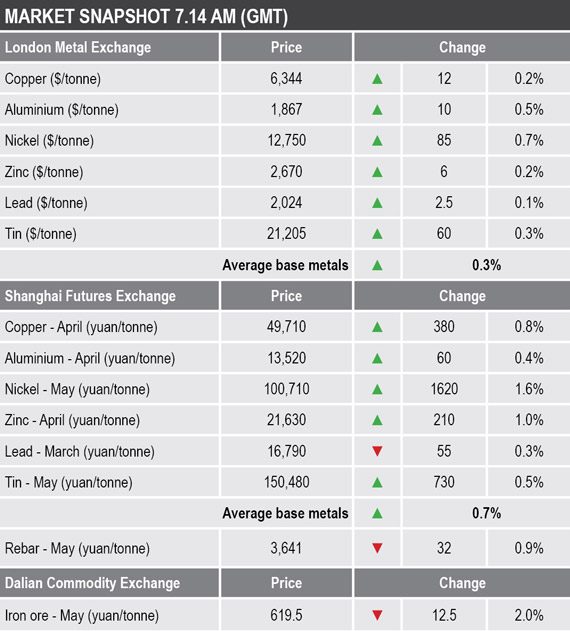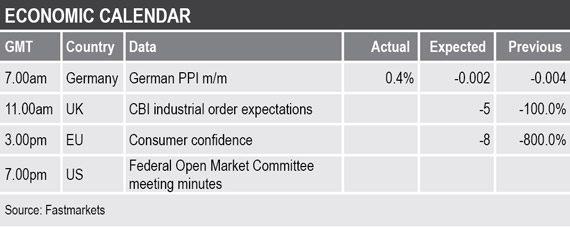Copper has generally led the move higher in recent days with prices reaching a high of $6,350.50 per tonne this morning, which has taken it well into the resistance area on the chart that lies between $6,290 per tonne and $6,394 per tonne.
This morning’s overall firmness came after a generally strong performance on Tuesday when with the exception of lead and tin, the rest of the base metals complex closed up with gains averaging 0.9%. Tin prices closed little changed on Tuesday at $21,145 per tonne, down by $10 per tonne from $21,155 per tonne on Monday, and lead prices closed at $2,664 per tonne, which was 0.4% lower than Monday’s $2,030-per-tonne close.
Volume across the complex has been above average with 8,647 lots traded as of 7.14am London time on Wednesday, compared with 4,403 lots traded at a similar time on Tuesday.
Spot bullion prices were stronger this morning with gold up by 0.2% at $1,342.18 per oz, compared with a previous close of $1,339.50 per oz, while silver was up by 0.4% at $16.00 per oz, from $15.95 per oz.
The platinum group metals (PGMs) were also stronger with palladium up by 0.9% at $1,490.20 per oz, compared with $1,477 per oz at Tuesday’s close, while platinum was up by 0.4% at $820.10 per oz, from its previous close of $817 per oz.
In China, base metals prices on the Shanghai Futures Exchange were for the most part stronger, the exception was lead where the March contract was down by 0.3%, while across the rest of the complex, which included April copper, April aluminium, April zinc, May tin and May nickel, gains averaged 0.9%. The April copper contract was recently quoted at 49,710 yuan ($7,345) per tonne, up from 49,330 yuan per tonne previously.
The spot copper price in Changjiang was up by 0.8% at 49,170-49,450 yuan per tonne, compared with 48,785-49,065 yuan per tonne on Tuesday, while the London/Shanghai copper arbitrage ratio was at 7.83, compared with 7.89 previously.
In other metals in China, the May iron ore contract on the Dalian Commodity Exchange continues to correct lower after the rally on the back of Vale SA’s tailings dam disaster – it was recently quoted at 619.50 yuan per tonne, compared with 632 yuan per tonne on Tuesday. On the SHFE, the May steel rebar contract was down by 0.9% at 3,641 yuan per tonne, compared with 3,673 yuan per tonne.
In wider markets, the spot Brent crude oil price was down by 0.24% at $66.28 per barrel from $66.45 per barrel previously – prices have formed and triggered a very clear inverse head-and-shoulder pattern on the chart.
The yield on US 10-year treasuries was recently quoted at 2.6406%, compared with 2.6654% at a similar time on Tuesday. The yields on the US 2-year and 5-year treasuries remain inverted and were recently quoted at 2.4861% and 2.4627% respectively. The German 10-year bund yield was recently quoted at 0.1000%, compared with 0.1050%.
Asian equity markets were for the most part stronger on Wednesday: Nikkei (+0.6%), Hang Seng (+0.91%), the CSI 300 (+0.36%), the Kospi (+1.09%), but the ASX 200 fell by 0.17%.
This follows a mixed performance in western markets on Tuesday; in the United States, the Dow Jones Industrial Average closed up 0.03% at 25,891.32, and in Europe, the Euro Stoxx 50 closed down by 0.17% at 3,239.41.
The dollar index’s latest run higher stalled ahead of resistance at 97.70, it peaked at 97.37 on February 15 and was recently quoted at 96.51. The weaker tone in the dollar has led to some strength amongst most of other major currencies we follow: the euro (1.1350), the Australian dollar (0.7158) and sterling (1.3030), although the yen is slightly weaker at 110.84.
The yuan had been trading sideways, but it has shown renewed strength on Wednesday and was recently quoted at 6.7223, compared with 6.7654 previously. Most of the other emerging market currencies we follow are either firmer or are flat.
On the economic agenda for Wednesday, data already released showed German producer price index climb 0.4%, this after a previous spike down by 0.4%. Later there is data on UK Confederation of British Industry (CBI) industrial order expectations that are expected to weaken. Since the start of 2017, the data has only been negative on five occasions.
In addition, there is data on EU consumer confidence, while from the US, the minutes from the Federal Open Market Committee (FOMC) are scheduled to be released at 7pm London time – the market will be waiting to see how dovish the FOMC members were – this may well be why gold prices have pushed higher in recent days.
Apart from lead prices that remain weak, the rest of the base metals are working higher, though it is only copper that is making significant headway – that said, tin has already done that in recent months. The surge in the cash/three-month backwardation on copper, combined with the price rise suggests short-covering by funds. With copper prices approaching the upper levels of the resistance on the chart it we wait to see if prices can break higher, if they do then that could instill confidence across the complex. Without any clarity of the US/China trade talks, it may be too early to get too bullish, especially as economic data still tends to be on the soft side.
The precious metals are looking strong, especially palladium and gold prices. Palladium continues to be driven by strong fundamentals, while gold prices seem to be on the rise while investors hedge against the uncertainties the global economy faces.



